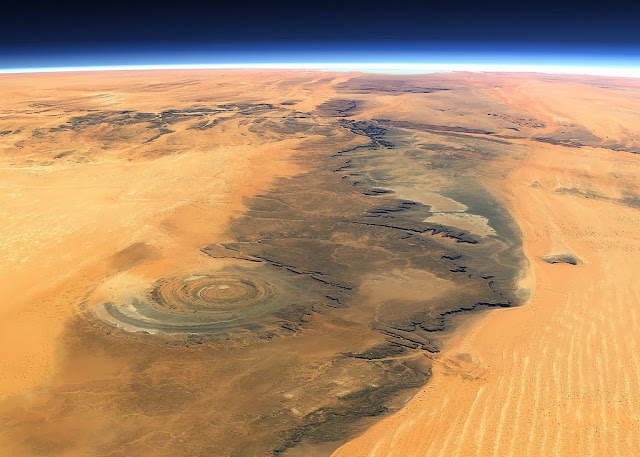The Eye Of Sahara - The Richat Structure
The Richat Structure, also known as the Eye of the Sahara and Guelb er Richat, is a huge circular formation in the Sahara desert of west–central Mauritania near Ouadane. This structure is a deeply eroded, slightly elliptical, 40-km in diameter, dome. This prominent circular feature in the Sahara desert has attracted attention since the earliest space missions because it looks like a gigantic bull’s-eye. The sedimentary rock exposed in this dome range in age from Late Proterozoic (2.5 billion years) within the center of the dome to Ordovician (480 million years) sandstone around its edges.
It was originally thought to have been an impact crater when it was first seen on a large scale by scientists. More research eventually revealed that it was not actually an impact crater, but instead a a circular anticline whose crest has been eroded away.
Erosion has created circular cuestas represented by three nested rings dipping outward from the structure. The center of the structure consists of a limestone-dolomite shelf that encloses a kilometer-scale siliceous breccia and is intruded by basaltic ring dikes, kimberlitic intrusions, and alkaline volcanic rocks. Several hypotheses have been presented to explain the spectacular Richat structure and breccia, but their origin remains enigmatic. The breccia body is lenticular in shape and irregularly thins at its extremities to only a few meters. The breccia was created during karst dissolution and collapse. Internal sediments fill the centimeter- to meter-scale cavities. Alkaline enrichment and the presence of Cretaceous automorphous neoformed K-feldspar demonstrate the hydrothermal origin of these internal sediments and their contemporaneity with magmatism. A model is proposed in which doming and the production of hydrothermal fluids were instrumental in creating a favorable setting for dissolution. The circular Richat structure and its breccia core thus represent the superficial expression of a Cretaceous alkaline complex with an exceptionally well preserved hydrothermal karst infilling at its summit.
There are a few other similar looking features that can be found in Africa: The Jebel Uwaynat that borders Sudan, Egypt and Libya and The Brandberg Intrusion in Namibia.
The Eye Of Sahara - The Richat Structure
 Reviewed by Vasanth
on
December 04, 2013
Rating:
Reviewed by Vasanth
on
December 04, 2013
Rating:









